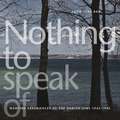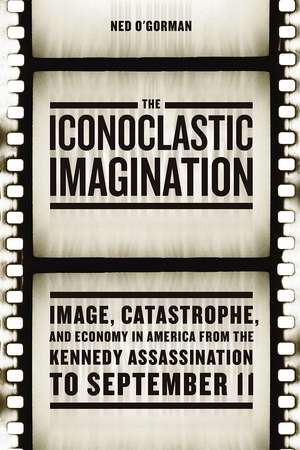The Iconoclastic Imagination: Image, Catastrophe, and Economy in America from the Kennedy Assassination to September 11: Emersion: Emergent Village resources for communities of faith
Autor Ned O'Gormanen Limba Engleză Paperback – 29 oct 2015
Bloody, fiery spectacles—the Challenger disaster, 9/11, JFK’s assassination—have given us moments of catastrophe that make it easy to answer the “where were you when” question and shape our ways of seeing what came before and after. Why are these spectacles so packed with meaning?
In The Iconoclastic Imagination, Ned O’Gorman approaches each of these moments as an image of icon-destruction that give us distinct ways to imagine social existence in American life. He argues that the Cold War gave rise to crises in political, aesthetic, and political-aesthetic representations. Locating all of these crises within a “neoliberal imaginary,” O’Gorman explains that since the Kennedy assassination, the most powerful way to see “America” has been in the destruction of representative American symbols or icons. This, in turn, has profound implications for a neoliberal economy, social philosophy, and public policy. Richly interwoven with philosophical, theological, and rhetorical traditions, the book offers a new foundation for a complex and innovative approach to studying Cold War America, political theory, and visual culture.
In The Iconoclastic Imagination, Ned O’Gorman approaches each of these moments as an image of icon-destruction that give us distinct ways to imagine social existence in American life. He argues that the Cold War gave rise to crises in political, aesthetic, and political-aesthetic representations. Locating all of these crises within a “neoliberal imaginary,” O’Gorman explains that since the Kennedy assassination, the most powerful way to see “America” has been in the destruction of representative American symbols or icons. This, in turn, has profound implications for a neoliberal economy, social philosophy, and public policy. Richly interwoven with philosophical, theological, and rhetorical traditions, the book offers a new foundation for a complex and innovative approach to studying Cold War America, political theory, and visual culture.
Din seria Emersion: Emergent Village resources for communities of faith
-
 Preț: 144.99 lei
Preț: 144.99 lei -
 Preț: 147.26 lei
Preț: 147.26 lei - 8%
 Preț: 311.68 lei
Preț: 311.68 lei -
 Preț: 146.50 lei
Preț: 146.50 lei - 18%
 Preț: 348.59 lei
Preț: 348.59 lei -
 Preț: 273.93 lei
Preț: 273.93 lei -
 Preț: 548.71 lei
Preț: 548.71 lei - 12%
 Preț: 290.56 lei
Preț: 290.56 lei - 8%
 Preț: 360.28 lei
Preț: 360.28 lei -
 Preț: 208.31 lei
Preț: 208.31 lei - 8%
 Preț: 563.24 lei
Preț: 563.24 lei -
 Preț: 302.76 lei
Preț: 302.76 lei -
 Preț: 279.55 lei
Preț: 279.55 lei -
 Preț: 176.35 lei
Preț: 176.35 lei - 18%
 Preț: 2261.34 lei
Preț: 2261.34 lei -
 Preț: 106.35 lei
Preț: 106.35 lei -
 Preț: 183.89 lei
Preț: 183.89 lei - 9%
 Preț: 352.50 lei
Preț: 352.50 lei - 9%
 Preț: 352.77 lei
Preț: 352.77 lei - 8%
 Preț: 346.31 lei
Preț: 346.31 lei -
 Preț: 209.88 lei
Preț: 209.88 lei -
 Preț: 176.49 lei
Preț: 176.49 lei - 6%
 Preț: 324.95 lei
Preț: 324.95 lei -
 Preț: 101.43 lei
Preț: 101.43 lei -
 Preț: 144.80 lei
Preț: 144.80 lei -
 Preț: 215.51 lei
Preț: 215.51 lei -
 Preț: 163.52 lei
Preț: 163.52 lei -
 Preț: 216.08 lei
Preț: 216.08 lei -
 Preț: 182.98 lei
Preț: 182.98 lei -
 Preț: 128.69 lei
Preț: 128.69 lei -
 Preț: 156.84 lei
Preț: 156.84 lei -
 Preț: 185.37 lei
Preț: 185.37 lei -
 Preț: 115.82 lei
Preț: 115.82 lei -
 Preț: 67.35 lei
Preț: 67.35 lei -
 Preț: 179.04 lei
Preț: 179.04 lei -
 Preț: 167.85 lei
Preț: 167.85 lei -
 Preț: 115.53 lei
Preț: 115.53 lei -
 Preț: 160.63 lei
Preț: 160.63 lei -
 Preț: 138.81 lei
Preț: 138.81 lei -
 Preț: 307.53 lei
Preț: 307.53 lei -
 Preț: 133.99 lei
Preț: 133.99 lei -
 Preț: 138.26 lei
Preț: 138.26 lei -
 Preț: 229.92 lei
Preț: 229.92 lei -
 Preț: 127.89 lei
Preț: 127.89 lei -
 Preț: 208.54 lei
Preț: 208.54 lei - 18%
 Preț: 502.35 lei
Preț: 502.35 lei - 9%
 Preț: 353.24 lei
Preț: 353.24 lei -
 Preț: 126.25 lei
Preț: 126.25 lei -
 Preț: 92.35 lei
Preț: 92.35 lei - 8%
 Preț: 564.99 lei
Preț: 564.99 lei
Preț: 175.20 lei
Preț vechi: 215.31 lei
-19% Nou
Puncte Express: 263
Preț estimativ în valută:
33.53€ • 34.74$ • 27.98£
33.53€ • 34.74$ • 27.98£
Carte indisponibilă temporar
Doresc să fiu notificat când acest titlu va fi disponibil:
Se trimite...
Preluare comenzi: 021 569.72.76
Specificații
ISBN-13: 9780226310237
ISBN-10: 022631023X
Pagini: 288
Ilustrații: 10 halftones, 2 line drawings
Dimensiuni: 152 x 229 x 20 mm
Greutate: 0.41 kg
Ediția:1
Editura: University of Chicago Press
Colecția University of Chicago Press
Seria Emersion: Emergent Village resources for communities of faith
ISBN-10: 022631023X
Pagini: 288
Ilustrații: 10 halftones, 2 line drawings
Dimensiuni: 152 x 229 x 20 mm
Greutate: 0.41 kg
Ediția:1
Editura: University of Chicago Press
Colecția University of Chicago Press
Seria Emersion: Emergent Village resources for communities of faith
Notă biografică
Ned O’Gorman is associate professor of communication and a Conrad Humanities Scholar at the University of Illinois at Urbana-Champaign. He is the author of Spirits of the Cold War: Contesting Worldviews in the Classical Age of American Security Strategy.
Cuprins
Preface
Introduction
Part I: Image
1: The Neoliberal Legitimation Crisis
2: The Iconoclastic Sublime
Part II: Catastrophe
3: Zapruder
4: Challenger
5: 9/11
Part III: Economy
6: America’s New Look
7: (Neo)Liberal Genealogies
Conclusion
Postscript and Acknowledgments
Notes
Bibliography
Index
Introduction
Part I: Image
1: The Neoliberal Legitimation Crisis
2: The Iconoclastic Sublime
Part II: Catastrophe
3: Zapruder
4: Challenger
5: 9/11
Part III: Economy
6: America’s New Look
7: (Neo)Liberal Genealogies
Conclusion
Postscript and Acknowledgments
Notes
Bibliography
Index
Recenzii
“O’Gorman is an elegant, critically rigorous, and accessible writer who situates insightful textual analyses within historical and theoretical discussions. The Iconoclastic Imagination focuses interdisciplinary attention to the relationships between visuality, contemporary politics, and neoliberalism that will, no doubt, contribute to recent reconsiderations of the Cold War and post–Cold War periods. This is a beautifully written discussion of the complexly interwoven philosophical and political traditions of both iconoclasm and the sublime in recent American history.”
“O’Gorman is setting out a powerful argument about American public culture, and one that contributes directly to current reconsiderations of visual representation, political aesthetics, media coverage of disasters, and cultural change. By exploring neoliberalism’s deep affinity with iconoclasm, this book reveals how ideology runs deeper than economic doctrine, how image analysis is a vital resource for social theory, and why catastrophe may become one of the characteristic themes of the twenty-first century.”
“O’Gorman offers a vital new reading of the ‘where were you when’ image-event in the era of neoliberal structural adjustment. Showing both the formation and limits of an American political culture increasingly reliant on the image to articulate the very terms of violence, The Iconoclastic Imagination is a provocative and timely intervention.”
“The book is an intellectual history, but also a history of state policy during the Cold War. It is a history of media, but also of political economy. It dabbles in the minutiae of film analysis, and it meanders from Byzantine iconography and Protestant iconoclasm through Thomas Hobbes’s Leviathan and Immanuel Kant’s theory of the sublime. It dizzies readers so they might orient themselves in a free-floating neoliberal imaginary. It demands complete attention.”
